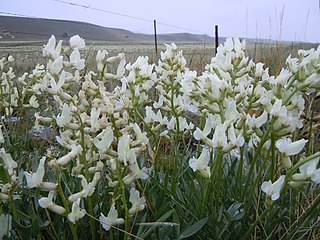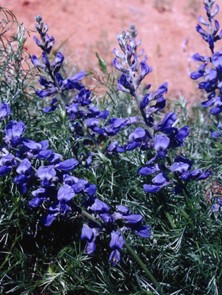Locoweed is a common name in North America for any plant that produces swainsonine, an alkaloid harmful to livestock. Worldwide, swainsonine is produced by a small number of species, most of them in three genera of the flowering plant family Fabaceae: Oxytropis and Astragalus in North America, and Swainsona in Australia. The term locoweed usually refers only to the North American species of Oxytropis and Astragalus, but this article includes the other species as well. Some references may incorrectly list Datura as locoweed.

Ranunculus repens, the creeping buttercup, is a flowering plant in the buttercup family Ranunculaceae, native to Europe, Asia and northwestern Africa. It is also called creeping crowfoot and sitfast.

Astragalus bisulcatus, commonly called two-grooved milkvetch or silver-leafed milkvetch, is a leafy perennial with pea-like flowers. It is native to central and western North America, and typically grows on selenium-rich soils. It accumulates selenium within its tissues, and when livestock consume it, the selenium can be toxic.

Rubus repens(dewdrop, false violet, star violet, Robin runaway. French Canadian: dalibarde rampante) is a perennial plant in the rose family, native to eastern and central Canada and to the northeastern and north-central United States. It is part of the genus Rubus, which includes brambles, blackberries, and raspberries. Some authorities consider it the sole member of a separate genus, Dalibarda. It is fairly easily grown in shady locations in damp to wet, acidic soils, and is frequently used in wildflower and bog gardens as a ground-cover.

Enceliopsis nudicaulis is a North American species of flowering plants in the family Asteraceae known by the common name nakedstem sunray, or naked-stemmed daisy.

Swainsona greyana, commonly known as the Darling pea or hairy-Darling pea, is a species of flowering plant in the family Fabaceae and is endemic to south-eastern continental Australia. It is an erect perennial subshrub with imparipinnate leaves with 17 to 21 egg-shaped leaflets, and racemes of 12 to 20 or more white, pink or purple flowers.

Oxytropis sericea is a species of flowering plant in the legume family known by the common names white locoweed, white point-vetch, whitepoint crazyweed, and silky crazyweed. It is native to western North America from Yukon and British Columbia south through the Pacific Northwest, the Rocky Mountains, and the Great Plains.

Cicuta bulbifera, commonly known as the bulb-bearing water-hemlock, is a plant native to North America and one of four species in the poisonous genus Cicuta. Tiny bulbils form in the leaf joints in the upper part of the plant, giving the plant its scientific and common names. Cicuta bulbifera can be distinguished from Cicuta douglasii by its narrow leaflet segments and its bulbil-bearing upper leaf axils.

Astragalus drummondii is a species of flowering plant in the legume family known by the common name Drummond's milkvetch. The botanist Thomas Drummond first identified the plant during his travels in North America from 1825 to 1835, the year of his death. Astragalus drummondii is one of many plants named after him. Upon the return of samples collected by Drummond to England, his findings were published in Sir William Hooker’s Flora Boreali-Americana in 1840.

Gaillardia pinnatifida, the Hopi blanketflower or red dome blanketflower, is a perennial plant in the family Asteraceae found in northern Mexico and in the south-central and southwestern United States.
Astragalus flavus is a perennial plant in the legume family (Fabaceae) found in the Colorado Plateau and Canyonlands region of the southwestern United States.

Sophora stenophylla, the fringeleaf necklacepod, or silvery sophora, is a perennial plant in the legume family (Fabaceae) found in the Colorado Plateau and Canyonlands region of the southwestern United States.

Penstemon comarrhenus is a perennial plant in the plantain family (Plantaginaceae) found in the Colorado Plateau and Canyonlands region of the southwestern United States.

Penstemon cyanocaulis, the bluestem penstemon or bluestem beardtongue, is a perennial plant in the plantain family (Plantaginaceae) found in the Colorado Plateau and Canyonlands region of the southwestern United States.
Aliciella subnuda is a biennial or perennial plant in the phlox family (Polemoniaceae) found in the Colorado Plateau and Canyonlands region of the southwestern United States.
Primula specuicola is perennial plant in the primrose family (Primulaceae) found in the Colorado Plateau and Canyonlands region of the southwestern United States.

Astragalus preussii is an annual or perennial plant in the legume family (Fabaceae) found in the Colorado Plateau and Canyonlands region of the southwestern United States.

Astragalus desperatus is a perennial plant in the legume family (Fabaceae) found in the Colorado Plateau and Canyonlands region of the southwestern United States.

Astragalus crassicarpus, known as ground plum or buffalo plum, is a perennial species of flowering plant in the legume family, Fabaceae, native to North America. It was described in 1813. The fruit is edible and was used by Native Americans as food and horse medicine. It is a host of afranius duskywing larvae. It is also known as groundplum milkvetch and pomme de prairie.
















